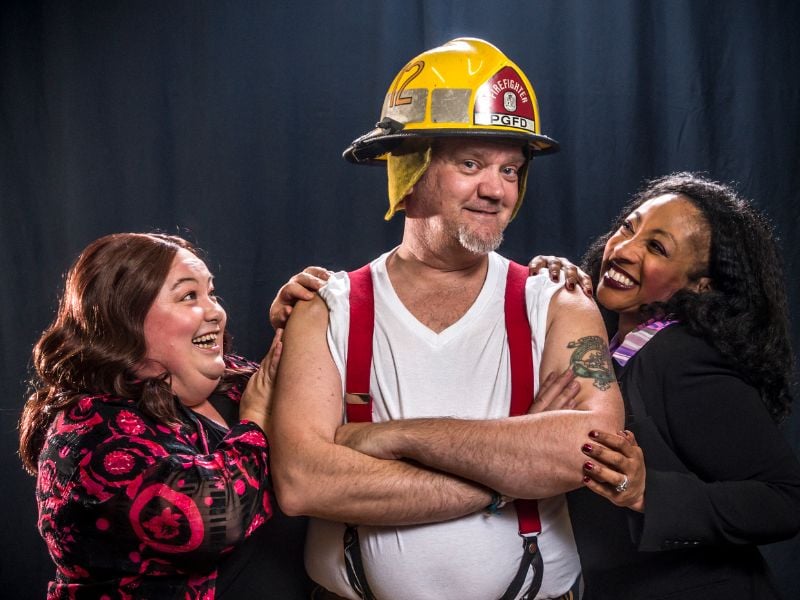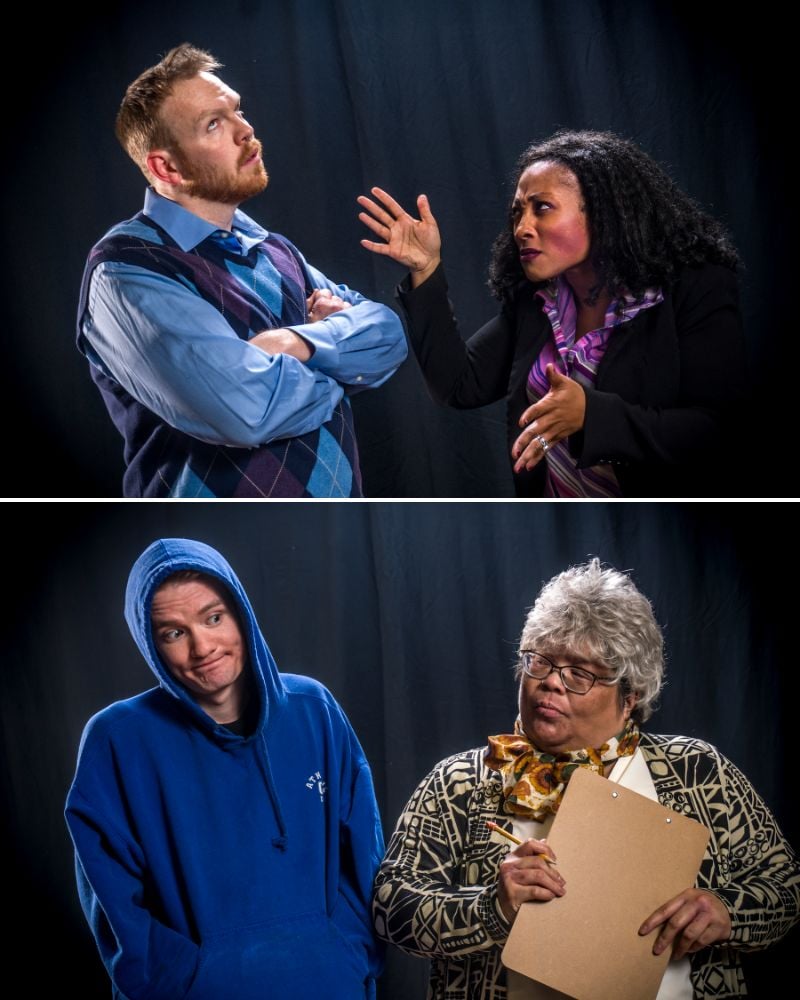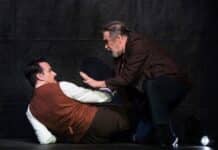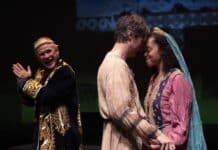Among the scores of musicals I have seen, Working is unique. It is the only one that deals seriously with what real people spend most of their waking lives doing.
Based on the popular 1974 nonfiction book of the same name by oral historian Studs Terkel’s interviews with working people about how they felt about their jobs, Working is an intensely collaborative piece, with a book by Stephen Schwartz and Nina Faso, and music and lyrics by Schwartz, Craig Carnelia, Micki Grant, Mary Rodgers, James Taylor, and Susan Birkenhead. It premiered at the Goodman Theatre in Chicago in 1977 — interestingly, two years after what may be its closest cousin, A Chorus Line, which, while in some ways a classic showbiz musical, also springs from interviews and deals with the motivations and feelings of unknown people about their work. Working opened on Broadway in 1978 and has since undergone numerous revisions, including in 2009, with three new songs by Lin-Manuel Miranda.

The current production by Colonial Players in Annapolis is the fruit of all these collaborations and changes. It is a living thing. A company of 10 actors portrays 27 very different people, expressing their feelings about their work in song, monologues, and dialogues. The dates of the vignettes are projected on screens around the theater, presenting the nature of work from the ’70s until today, including technology from CB radios to cell phones.
Director Tom Wyatt has stitched together this complicated work almost seamlessly, from his fine casting, to bringing all the disparate elements together. He has made good use of the oval, in-the-round setup of the CP stage, taking care to preserve sight lines for everyone in the audience and make sure they can always see at least some actors’ faces (although the characters on the center line could have been staggered just a bit in group numbers). The problem of how to juggle the actors’ positions convincingly is trickier; sometimes it is naturalistic — at one point an actor makes as if to leave, then turns around in the exit as if he forgot to say something, giving the audience on the other side of the stage a full view of him. Other times, it is almost turned into a joke, with an actor running as if to catch up with her light. The ones where the actors seem to have motivation for their moves are the most effective. But with the audience only three rows deep, there really are no bad seats in the house. The director also makes sure the actors take great care in realistically miming the work they are doing, from office workers typing on computer keyboards or monotonously moving a mouse, to a stone mason expertly laying mortar and rock, to the backbreaking, boring and yet almost balletic work of steaming a suitcase into shape every 40 seconds.
The technical aspects also serve the story well. Edd Miller’s set consists of stylized gears painted into the center of the stage, and video screens positioned around the walls where all audience members can see them. There is also a pair of windows on one wall, and an alcove representing a corner office. Everything else (besides occasional rolling chairs and computer stands) is left to the miming of the actors and the imagination of the audience.
Diane Trickey-Rokenbrod’s lighting is quite effective, for the most part. While occasionally area lights seem to come up too early, causing actors to rush to get into them, or too late, leaving them in dimness for a few seconds, there are several projections of firelight — first in the center of the stage indicating a campfire, and then in the windows on the wall evoking a house fire — that are quite impressive.
Beth Terranova’s costumes are ordinary yet meaningful. Firefighters, tree climbers, office workers, mill workers, sex workers, truckers, socialites, caretakers, retirees are all delineated clearly yet unobtrusively. There is a fast food worker with an amusingly universal uniform, a chorus of cleaning ladies in charming pink scrub tops, and an absolutely gorgeous pink waitress outfit fit for a star — which is fitting, because this waitress actually sees herself as one, in the delightful number “It’s an Art.”
Many of the character changes are accomplished through Maria Neves’s wigs, with varying success. Given how fast some of the costume changes need to happen, in most cases, a good wig is one that doesn’t draw attention to itself.
There is no musical director listed, but there is a four-piece band (Reid Bowman, Bass; Marie Hansen, Piano; Jefferson Hirschman, Guitar; Jeremy Ulrich, Percussion) that provides unobtrusive support for the voices and excellent harmonies of the cast.
And quite a cast it is. All are top-notch; some stand out.

Lance Teller has a soaring voice and is charmingly funny as a fast-food worker feeling free when out for “Delivery,” and touchingly real as the son of the stonemason in “The Mason.” Ben Carr presents a dedicated fireman, but still perfectly portrays the slimy Gordon-Gecko-like CEO who knows that people like him have the perfect right to run the world. His self-satisfied musing that when he retires he might actually want to teach and “pass on his wisdom” contrasts painfully with Cheryl J. Campo’s actual schoolteacher, trying to make it to her own retirement while dealing with a bewildering new generation of students in “Nobody Tells Me How.” Kristen Cooley is wrenching as an exhausted mill worker who does it because it’s all she can do (“The men all quit,” she says. “It’s too boring for them. They can only think about one thing at a time”) in “Millwork.” Then she delights taking the lead in “Cleanin’ Women,” singing about how, if it’s up to them, their daughters will never have to clean for other people as their mothers did, and they do.
Kyle Eshom and Cheryl J. Campo are equally heartrending in “A Very Good Day” as an elder-care worker and a nanny who show their commitment to their charges while stating bluntly, “I do the work that no one else will do.” Christian Gonzalez sparks laughter in a monologue about the joys of wearing a tool belt as an ironworker and a tree-climber, and his voice is achingly beautiful singing the Spanish lyrics in “Un Mejor Dia Vendra” (alongside Lance Teller’s English monologue) about living as a migrant worker — a piece everyone needs to hear right now.
Sarah Kent is equally funny as a deli owner who improbably wants to be a fashion designer, and a socialite/fundraiser who is more similar than she knows to Tia Silver’s enterprising escort/prostitute. Silver also hits all the right notes as a harassed project manager, and a college student who knows she is destined for great things but might just have to “settle for” being an entrepreneur. She most captivates the audience in her plaintive anthem to that most underappreciated job, “Just a Housewife.”
Samantha McEwen Deininger delivers a marvelous monologue as a flight attendant, and an even more spectacular star turn as a waitress who takes pride in her work (perhaps more than she deserves to) in “It’s an Art.” Both her voice and her acting are superb.
And Peter N. Crews proves a chameleon who grabs the audience’s heart in every character he portrays, from the lead in the song “Brother Trucker,” where he talks on the CB radio, fantasizes about women on long trips, and always finds a reason not to go home to his wife; to the stonemason who takes pride in every stone he lays, knowing they will last; to a very funny, very nervous PR manager; to an utterly mesmerizing turn as “Joe,” a retired man who visibly ages decades in the few minutes he is on the stage. The show is worth seeing for his performance alone.
But there is so much more.
Perhaps the best thing about Working is the one that makes it most unusual. As conceived by Daniel C. Levine, the monologues and songs are interspersed with video interviews with real, local people about their jobs, which are relevant to the subjects being touched on in the show. They include a hairdresser, a social worker, a community leader, an archivist, a bartender, a retired pilot, and a shipbuilder. The most moving interview presents a man named Floyd Tasker, the custodian for the Colonial Players. “I love to work,” he says. “I’ve never had a job I didn’t like. Sometimes I’ve had five or six jobs at the same time, and I’ve loved every single one of them.” Of all the workers in the show, he may be the most admirable.
Working overflows with things we all do and think about every day. At one point an office drone says, “This is the first time in generations our lives will be worse than our parents’.” The cast sing sadly about lost dreams in “If I Could Have Been.” But they express pride in their work, whatever it is, insisting that every building should have the names of everyone who worked on it or in it etched in stone around the base, because everyone should have “Something to Point To.” In one of the last numbers in the show, “Fathers and Sons,” the singers reveal that ultimately the most important reason many people work is for their kids. In the performance I saw, a cast member could be seen wiping tears from his eyes — and it seemed to be a private, emotional moment, not an act. The show was that real for him, and that made it even more real for the audience.
No one here is magically beautiful, or having their big break into fame, or leading a revolution, or destined to fall in love by the finale. These people do, think, and feel the same things we all do, every day. The mundanity and futility, as well as the necessity, nobility and humanity, of sheer hard work shine through every word and every note. Working is a musical about ordinary people and their ordinary lives, and that makes it extraordinary.
I cannot emphasize this enough. This show is unique. You will never have a chance to see this particular production ever again.
Do not miss it.
Running Time: Approximately two hours and 30 minutes, including one intermission.
Working plays through March 29, 2025 (Thursdays–Saturdays at 8 pm; Sunday matinees March 16 and 23 at 2 pm), at Colonial Players of Annapolis – 108 East Street, Annapolis, MD. For tickets ($21–$26), call the box office at 410-268-7373, opt 2, or purchase online. A virtual playbill is available here.
Contains strong language and mature themes.
Working
From the book by Studs Terkel
Adapted by Nina Faso & Stephen Schwartz
Localized format conceived by Daniel C. Levine for ACT of CT
Directed by Tom Wyatt




